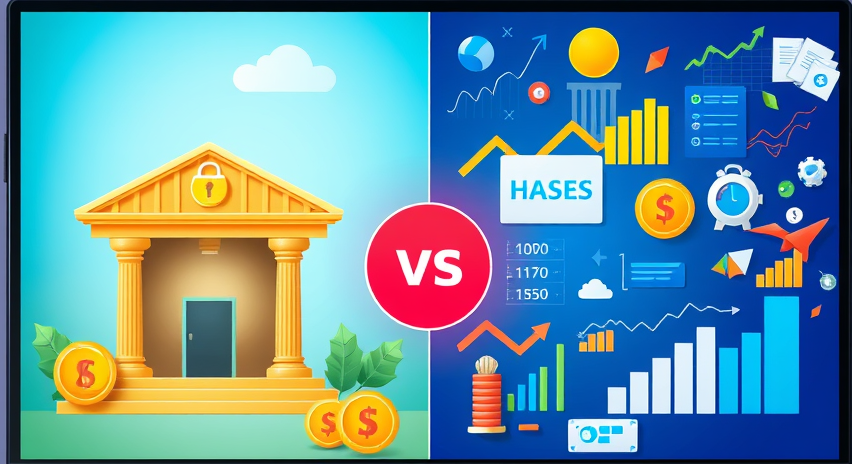Mutual Fund vs Fixed Deposit – உங்களுக்கான சரியான முதலீடு எது? 2025 முழுக்க Updated Guide!

நம்ம இந்தியர்களுக்கு FD (Fixed Deposit) என்றாலே ஒரு emotional connection இருக்கு – “பணத்தை bank-ல் வைத்து பாதுகாப்பாக வைக்குறது தான் செம்ம idea” என்று நம்ம பாட்டிகள், மாமா எல்லாம் சொல்லுவாங்க. ஆனால் இப்போ நம்ம Gen-Z, millennial வழிகாட்டிகள் மற்றும் financial advisors சொல்வது என்ன? Mutual Fund தான் growth-க்கு king!
2025-ல் வந்து interest rates fluctuate ஆகுது, inflation எகிறுது, bank FD interest 6% கூட வரல, அப்படின்னா mutual funds மாதிரி options explore பண்ணனும் தானே? ஆனால் நம்ம பயமும் இருக்குது – market crash ஆகலாம், capital loss ஆகலாம்… இதெல்லாம் எப்படி manage பண்ணலாம்?
இந்த blog-ல், Mutual Funds vs Fixed Deposit-ஐ practical-ஆன angle-ல compare பண்ணப்போறோம். எது safe? எது profitable? எது emergency-க்கு use ஆகும்? எது retirement-க்கு suit ஆகும்? இப்படி full comparison – so you can take a smart and confident financial decision!
Mutual Fund vs FD – இரண்டும் எப்படி வேலை செய்கிறது.? யாருக்கு எது பொருத்தம்.?
ஒரு நல்ல முதலீடு செய்யணும்னா, அந்த financial product எப்படி வேலை செய்கிறது என்பதை முதலில் புரிந்துக்கணும். FD-யும் Mutual Fund-உம் இரண்டு விதமான route-ல நம்ம பணத்தை growth செய்ய பணியாற்றும் – ஆனால் அவர்கள் working mechanism-ல் பெரிய வேறுபாடுகள் இருக்கு.
💡 Fixed Deposit (FD) எப்படி வேலை செய்கிறது?
FD என்பது ஒரு traditional investment method. நீங்க ஒரு குறிப்பிட்ட தொகையை (ex: ₹1Lakh) ஒரு certain period (say 5 years) bank-க்கு கொடுக்கிறீங்க. அந்த amount-க்கு bank ஒரு fixed interest (say 6.5%) தரும். இந்த interest annually அல்லது quarterly உங்கள் account-க்கு credit ஆகும்.
📌 முக்கிய அம்சம்: Interest rate ஆரம்பத்திலேயே decide ஆகும். அதாவது market எப்படி மாறினாலும், உங்கள் FD interest மட்டும் change ஆகாது.
உதாரணம்:
2025-ல் ₹1,00,000 FD-ல 6.5% interest-க்கு 5 years வச்சீங்கன்னா:
₹1,00,000 × (1 + 0.065)^5 = ₹1,37,000 approx.
Profit: ₹37,000 (Taxable).
👉 இது ஒரு low-risk, predictable return method. ஆனால் inflation பாதிப்பை beat பண்ண முடியாது.
📊 Mutual Fund எப்படி வேலை செய்கிறது.?
Mutual Fund என்பது நம்ம பணத்தை ஒரு professional fund manager பல வகையான securities-ல் (stocks, bonds, etc.) invest பண்ணி return தரும் ஒரு collective investment method. இது market performance-ஐ அடிப்படையாக வைத்து return தரும். அதனால் return fluctuate ஆகும்.
முக்கிய அம்சம்:
- Risk இருக்கும், ஆனா return potential அதிகம்.
- Compounding power அதிகம் (especially SIP).
- Equity fund-ல் average CAGR 10–14% வரைக்கும் உள்ளது.
📌 உதாரணம்:
₹1,00,000 mutual fund-ல 12% CAGR-க்கு 5 years வச்சீங்கன்னா:
₹1,00,000 × (1 + 0.12)^5 = ₹1,76,000 approx.
Profit: ₹76,000 (LTCG applicable only above ₹1L profit)
🆚 Side-by-Side Comparison Table:
| Feature | Fixed Deposit (FD) | Mutual Fund (Equity Type) |
|---|---|---|
| Risk Level | Low (Bank guaranteed) | Medium to High (Market-based) |
| Return Type | Fixed | Variable (Based on fund & market) |
| Compounding | Simple/Compound annually | Continuous Compounding |
| Professional Mgmt | Not Required | Fund Manager manages |
| Example Return | ₹1L ➡ ₹1.37L in 5Y | ₹1L ➡ ₹1.76L in 5Y (12% CAGR) |
| Market Impact | No | Yes |
| Inflation Adjust | Poor | Good |
🧠 Maaran Expert Take:
அந்தந்த கால கட்டத்தில FD interest தான் அதிகமா இருந்தது. ஆனா இப்போ (2025), bank interest rates 6%-க்கு கீழ இருக்குறதால FD-ன் real return (inflation adjust பண்ணினா) சுமார்தான். அதே நேரத்தில், Mutual Fund-ல் return unpredictable-ஆ இருந்தாலும் long-term-ல் wealth build பண்ணற power அதிகம் இருக்கு.
📌 Key Insight:
FD என்பது safety-க்கு. Mutual Fund என்பது growth-க்கு.
நீங்க conservative investor-னா FD-ஐ முதலில் தேர்வு பண்ணலாம். ஆனா goal-oriented, long-term wealth creators-னா mutual fund-ஐ பயப்படாம explore பண்ணணும்.
Safety vs Growth – Risk–Return balance யாருக்கு தான் நல்லது?
ஒரு முதலீடு செய்யும் போது, நம்முடைய மனதில் வரும் முதல் கேள்வி – “என்ன safe?” அடுத்தது – “எவ்வளவு return வரும்?” ஆனால் இந்த இரண்டு விஷயமும் ஒரே நேரத்தில் perfect-ஆ meet ஆகும் என்று கிடையாது. அதான் risk-return balancing அப்படிங்கற concept-ன் முக்கியத்துவம்.
🛡️ FD – Safety முன்னிலையில இருக்குறதா.?
Fixed Deposit-ல் நீங்கள் bank-க்கு ஒரு fixed amount கொடுக்கிறீங்க. அந்த bank RBI-யின் கட்டுப்பாட்டில் இருக்குது. அதனால FD is one of the safest investments.
2025-க்கு முன்னர், FD interest rates 8%-க்கும் மேலா இருந்தது. ஆனால் இப்போ (2025) interest 6%–6.5% தான்.
📌 Risk Level:
- Bank failure ஆகாம இருக்குற guarantee-யும் இருக்கு (up to ₹5 Lakhs insurance – DICGC coverage).
- Capital loss ஆகாது.
- Withdrawal rules அதிகம் இல்ல.
✅ Suitable for:
- Retired persons
- Emergency funds
- Conservative investors
📉 Downside:
- Inflation beat பண்ண முடியாது.
- Taxable income.
📈 Mutual Fund – Growth வேகமா வரும் ஆனா Risk கூடவே..?
Mutual Fund-ல் equity exposure இருக்குறதால, market performance-ஐத்தான் major impact-ஆ காண்றோம். இது risky-ஆ இருக்கலாம், ஆனா long-term-ல maximum wealth creation பண்ணக்கூடிய வழி இது தான்.
📌 Risk Level:
- Market fluctuations adhigam.
- Profit high-ஆ இருக்கலாம், loss face பண்ண வேண்டிய situation-ம் வரும்.
- Short-term-ல uncertainty, long-term-ல compounding advantage.
📈 Example:
SIP ₹2000/month for 15 years – CAGR 12% => ₹11.5 Lakhs approx.
Same amount FD-ல் 6.5% => ₹7 Lakhs approx.
✅ Suitable for:
- Youth investors
- Long-term goals (child education, retirement)
- Medium to high risk appetite உள்ளவர்கள்
📉 Downside:
- Emotional panic sell முடிவு பண்ணிடலாம்
- Time & patience தேவை
⚖️ Real-world Comparison:
| Investor Type | Best Choice |
|---|---|
| 60+ Senior Citizen | FD |
| 25-Year IT Professional | Mutual Fund (SIP) |
| Housewife with ₹1L | Mix of FD + MF |
| Goal-based saver | SIP with ELSS/Hybrid |
🧠 Regional Insight:
மரணம்/கொள்கை-அழிவில்லா பாதுகாப்பு தேவைப்படுறதா.? – FD.
நாளைய வாழ்க்கையை better-ஆ மாற்ற ஆசையா.? – Mutual Fund.
தமிழ்நாட்டில் பார்த்தா, கடந்த 5 வருடத்தில் FD adoption குறைந்தாலும், SIP account registrations per year 22% growth-ஆ increase ஆச்சு. இந்த trend future-ல் growth-focused savings க்கு shift ஆகுறதைக் காட்டுகிறது.
Returns Battle – FD vs Mutual Fund, யாருக்கு என்ன level-ல benefit கிடைக்கும்?
ஒரு முதலீட்டின் ultimate goal தான் – “எவ்வளவு பணம் கிடைக்கும்?” அதனால mutual fund vs FD return comparison-ஐ நம்ம deep-ஆ பார்ப்போம். இது தான் decision எடுக்கறதுக்கு turning point!
📉 FD Returns – Predictable ஆனா Low Growth
Fixed Deposit-ல் return fix பண்ணபட்ட interest rate-அதான். இந்த rate எல்லா bank-லும் வெவ்வேறாக இருக்கும். 2025-ல் சில முன்னணி banks 6.5% வரை annual interest தருகிறாங்க.
📌 Standard FD Return Rates (2025):
| Bank | Interest Rate (5Y FD) |
|---|---|
| SBI | 6.5% |
| HDFC Bank | 6.6% |
| Post Office TD | 7.0% |
| Senior Citizen FD | +0.5% Extra |
🎯 ₹1,00,000 FD in 5 years @6.5%:
👉 Maturity = ₹1.38 Lakhs
👉 Net Profit = ₹38,000 (before tax)
🔍 10 Years @6.5%:
👉 ₹1L ⇒ ₹1.89 Lakhs
👉 Net Profit = ₹89,000
❌ Tax Alert:
- Interest fully taxable.
- After tax, actual gain drops to ~4.5% (for 30% slab).
📈 Mutual Fund Returns – Volatile ஆனா Power-packed Growth
Mutual Fund, especially Equity-based SIP-ல் returns fluctuate ஆகும். ஆனால் long-term-ல் market trends positive-ஆ இருந்து வந்திருக்குது.
📌 Average Mutual Fund CAGR (Past 10–15Y):
| Fund Type | Average 5Y CAGR | 10Y CAGR |
|---|---|---|
| Large Cap | 10–12% | 11–13% |
| Mid Cap | 12–14% | 14–16% |
| Flexi Cap | 11–13% | 12–14% |
| ELSS | 11–14% | 13–15% |
🎯 ₹1,00,000 SIP – 10 Years @12% CAGR:
👉 Maturity = ₹3.1 Lakhs
👉 Net Profit = ₹2.1 Lakhs
🎯 ₹5000/month SIP – 15Y @12%:
👉 Maturity = ₹25.4 Lakhs
👉 Invested = ₹9 Lakhs
👉 Profit = ₹16.4 Lakhs
✅ Tax Edge:
- ₹1L/year LTCG exempt
- Post-tax return > FD
🧮 Side-by-Side Real-Example:
| Criteria | FD @6.5% | Mutual Fund @12% |
|---|---|---|
| ₹1L for 10Y | ₹1.89L (Taxable) | ₹3.10L (₹1L tax-free) |
| ₹5K/month – 15Y | ₹13.6L | ₹25.4L |
| Risk | Very Low | Moderate |
| Liquidity | Medium | High (except ELSS) |
| Tax | Full Interest Tax | LTCG > ₹1L taxed |
📌 Case Study: Mr. Dinesh vs Mrs. Priya
Dinesh – ₹1L FD @ 6.5%
👉 After 10Y = ₹1.89L
👉 Paid tax ~₹12K
👉 Net = ₹1.77L
Priya – ₹1L in Flexicap MF
👉 After 10Y = ₹3.1L
👉 Profit = ₹2.1L
👉 LTCG under ₹1L ⇒ No tax
👉 Difference: ₹1.3 Lakhs (74% more gain)
✅ My final Verdict:
If “Growth” your goal → Mutual Fund
If “Safety” your concern → FD
But modern financial planners சொல்லுறது:
💡 “Return without beating inflation is actually a loss!”
So, even ₹5000 SIP/month-ஆனாலும் start பண்ணுங்க. FD-வை emergency fund-ஆ convert பண்ணுங்க. அதுவே long-term winning strategy.
Tax Benefit & Withdrawal Rules – FD vs Mutual Fund-ல் யாருக்கு சலுகை அதிகம்?
முதலீட்டுல return மட்டும் பாத்தா போதாது. அதனுடன் வரவேண்டியது தான் Tax Benefit. அதே நேரத்தில், எந்த அளவுக்கு flexibility-யா withdrawal பண்ண முடியும் என்பதும் முக்கியமான factor.
💰 Fixed Deposit Taxation – Interest Full Tax ஆகும்!
FD-ல வரக்கூடிய interest income, “Income from Other Sources”-ஆ classify ஆகும். அதாவது, உங்கள் income slab-க்கு ஏற்ப full tax pay செய்ய வேண்டி வரும்.
📌 Example:
- Mr. Raj ₹1L FD interest @6.5% ⇒ ₹6,500/year
- அவர் 30% slab-ல் இருந்தால் ⇒ ₹1,950 tax!
FD-யில் Section 80C benefit கிடைக்குறது only for 5Y Tax Saver FD-க்கு மட்டும். ஆனால் அதிலும் maturity interest taxable தான்.
👉 FD Interest:
- No exemptions (except 80TTB senior citizens – ₹50K)
- TDS applicable if interest >₹40K/year (₹50K for seniors)
📈 Mutual Fund Taxation – Smart Investor-க்கு Edge!
Mutual funds, especially ELSS-ல் முதலீடு பண்ணினா, Section 80C-ல் ₹1.5L deduction கிடைக்கும். அதே நேரத்தில், equity mutual fund-ல் வரும் profit-ஐ LTCG (Long Term Capital Gain)-ஆ tax செய்யும் system இருக்கு.
📌 Tax Rates:
| Fund Type | Holding Period | Tax Rate |
|---|---|---|
| Equity Fund | > 1Y | 10% after ₹1L LTCG |
| Debt Fund | > 3Y | 20% with indexation |
| ELSS | 3Y Lock-in | Same as Equity |
📌 Example:
- ₹2L ELSS Maturity
- Profit = ₹80K → No LTCG (below ₹1L exempt)
👉 Mutual fund-ல் TDS இல்லை
👉 Only if redemption-ல் profit > ₹1L/year வந்தா tax வரும்
🏦 Withdrawal Rules:
FD:
- Regular FD – break anytime (with penalty ~0.5–1%)
- Tax Saver FD – 5 years lock-in (cannot break early)
Mutual Fund:
- ELSS – 3Y lock-in
- Others – Anytime withdraw possible
- SIP – each installmentக்கு individual 3Y lock-in (ELSS)
📌 Flexibility-வச்சு பார்த்தா Mutual Fund தான் winner!
✅ Final Thought:
| Feature | FD | Mutual Fund |
|---|---|---|
| Tax Benefit | Only 5Y Tax Saver FD | ELSS under 80C |
| Maturity Tax | Full Interest Taxable | ₹1L LTCG Exempt |
| Withdrawal | Early break = penalty | Anytime (except ELSS) |
| Liquidity | Moderate | High |
💡 High income slab-ல் இருந்தீங்கன்னா, FD-ல வந்து tax வலி அதிகமா தெரியும். Mutual fund-ல smart planning பண்ணீங்கனா, tax மட்டும் இல்லாமல் compounding return கூட கிடைக்கும்!
Risk, Inflation & Goal Matching – FD vs Mutual Fund யார் Future-க்கு Real Value தருகிறாங்க.?
ஒரே ₹1 Lakh-ஐ இன்று FD-ல வைச்சாலும், Mutual Fund-ல வைச்சாலும்… 10 வருடத்திற்கு பிறகு அந்த money-க்கு இருக்கும் “real value” என்பது பெரிய வித்தியாசமா இருக்கும். காரணம் – Inflation.
🔥 Inflation – உங்கள் பணத்தின் மதிப்பை குறைக்கும் பூச்சி!
2025-ல் ₹1000-க்கு வாங்க முடிந்த பொருள், 2035-ல் ₹1800 ஆகும். இதுதான் inflation impact.
அதாவது, உங்கள் investment return, inflation-ஐ beat செய்யணும். இல்லன்னா actual power of money குறைந்து போயிடும்.
🏦 FD – Low Risk, Low Growth!
FD safe தான் – அதில் சந்தேகம் இல்லை. அதே நேரத்தில், interest rate 6%–7% மட்டுமே இருக்கிறது. Inflation average 6%–7% இருக்கும் போது, FD-ல் growth real-a குறைவா இருக்கும்.
📌 Example:
- ₹1L in FD @ 6.5% for 10Y = ₹1.9L
- Inflation 6.5% → Real value = Same old ₹1L தான்!
அதாவது, FD protects your capital, not grows it. Long-term goal-க்கு இது best option இல்ல.
📈 Mutual Fund – Volatile but Powerful
Mutual funds, especially equity-oriented funds, market-based instruments. Risk இருக்கு. ஆனால் past 10Y CAGR 12%–14% வரைக்கும் mutual funds கொடுத்திருக்குது.
📌 Example:
- ₹1L in MF @ 12% for 10Y = ₹3.1L
- Inflation 6.5% ⇒ Real Value = ₹1.65L approx (Still 65% higher than FD)
இந்த மாதிரியான return தான் future-ல் education, marriage, retirement போன்ற goals-க்கு support பண்ணும்.
🧠 Goal-Based Planning – Mutual Fund தான் Tailor Fit!
- Short-term goals: FD safe (1–3Y)
- Medium-term: Balanced MF or Debt MF
- Long-term: Equity Mutual Fund
📌 Goal-based investing-க்கு Mutual Fund தான் flexible. Fund type, duration, amount எல்லாமே adjust பண்ண முடியுது.
FD-ல் இப்படி customization இல்லை.
🎯 Risk Comparison:
| Risk Type | FD | Mutual Fund |
|---|---|---|
| Capital Risk | Zero | Moderate (market-based) |
| Interest Rate Risk | Fixed, but low return | Can vary, but potential high |
| Inflation Risk | High (returns < inflation) | Low (returns > inflation) |
💡 Risk-ஐ avoid பண்ண முடியாது. But Smart Plan பண்ணி, Risk-ஐ absorb பண்ணி growth create பண்ணலாம்! Mutual Fund அதுக்கான best tool.
👥 Real-Life Case Study – Mr. Kumar vs Mrs. Anitha: இரண்டு நபர்களின் பங்கு மற்றும் FD சேமிப்பு பயணம்
ஒரே மாதிரியான குடும்பப் பின்னணி, ஒரே மாதிரியான வருமானம்… ஆனாலும் இரண்டு பேர் எடுத்த முடிவுகள் எப்படி future-ஐ impact பண்ணுது என்பதை பார்க்கப்போறோம். இது நிறைய finance beginners-க்கு open-eye example ஆக இருக்கும்.
👨💼 Mr. Kumar – Mutual Fund SIP Investor
- Age: 30
- Profession: IT Employee – Monthly Salary ₹50,000
- Investment Plan: ₹5000/month SIP (Equity Mutual Fund – Flexicap)
- Started: Jan 2015
🔍 Growth Over Time:
| Year | Total Invested | Portfolio Value (CAGR 12%) |
|---|---|---|
| 2020 | ₹3 Lakhs | ₹4.9 Lakhs |
| 2023 | ₹5 Lakhs | ₹8.1 Lakhs |
| 2025 | ₹6 Lakhs | ₹10.4 Lakhs |
✅ Total Profit: ₹4.4 Lakhs
✅ Withdraw Flexibility: Anytime
✅ Tax: LTCG applicable after ₹1L gain/year
📌 Kumar Says: “First time investment பண்ணும் போது பயம் இருந்துச்சு… but SIP discipline வைத்தேன். இப்போ ஒரு குழந்தையின் future-க்கு solid backup ready!”
👩💼 Mrs. Anitha – FD Saver
- Age: 32
- Profession: School Teacher
- Investment Plan: ₹5000/month FD
- Interest Rate: 6.5% average
- Started: Jan 2015
🔍 Growth Over Time:
| Year | Total Invested | FD Value |
|---|---|---|
| 2020 | ₹3 Lakhs | ₹3.7 Lakhs |
| 2023 | ₹5 Lakhs | ₹6.15 Lakhs |
| 2025 | ₹6 Lakhs | ₹7.4 Lakhs |
✅ Safe capital
❌ Return not beating inflation
✅ No tax on interest below ₹40K/year
📌 Anitha Says: “அதிகமான return கிடைக்கல. ஆனால் நல்ல நிம்மதி இருக்கு. எப்பவும் predictable.”
💡 Learning from Both:
- Kumar took calculated risk → Higher return
- Anitha stayed conservative → Safe but slow
👉 Conclusion: Risk எடுத்து Mutual Fund பண்ணதுனாலே Kumar long-term wealth create பண்ண முடிச்சார். Anitha FD-ல discipline இருந்தாலும் inflation beat பண்ண முடியல.
❓ FAQ Section – Mutual Fund vs FD பற்றி அதிகம் கேட்கப்படும் 5 கேள்விகள்!
Q1: Mutual Fund-ல் risk இருக்கா? அப்படி என்றால் எவ்வளவு?
✅ ஆம், Mutual Fund என்பது market-based investment system, அதனாலே fluctuations இருக்கும்.
📌 Equity Fund-ல் risk அதிகம், ஆனால் long-term-ல் CAGR 12%-13% வரைக்கும் grow ஆகும்.
📌 Conservative நபர்களுக்கான option: Debt Funds – low risk, low return (6–7%).
Q2: FD investment-க்கு எந்த bank safe? Return யாரு அதிகம் தராங்க?
🏦 Nationalised banks (SBI, Indian Bank) safe.
💼 Private banks (IDFC, RBL, Bandhan Bank) higher interest offer பண்ணலாம் – but check credit rating before investing.
📌 Senior Citizens FD – extra 0.25%–0.75% interest.
Q3: Mutual Fund-ல் return எவ்வளவு வரலாம்? Guaranteed-a?
📈 No, returns are not guaranteed. Market performance-ஐப் பொருத்தது.
📊 Average historical return:
- Equity MF – 10–14% CAGR
- Hybrid Fund – 8–10%
- Debt Fund – 6–7%
👉 Long-term hold பண்ணினால், volatility-ஐ absorb பண்ணி better result கிடைக்கும்.
Q4: FD-ல் TDS applicable-a? Mutual Fund-ல் tax எப்படி வரும்?
💰 FD interest ₹40,000/year-ஐ மீறினால் TDS applicable.
📌 Senior Citizens limit – ₹50,000/year.
💰 Mutual Fund tax:
- LTCG (Long Term Capital Gain): ₹1L/year வரை exempt.
- மேலே வந்தால் 10% tax.
- STCG: Less than 1 year holding – 15% tax.
Q5: ஒரு நேரத்தில் Mutual Fund & FD இரண்டையும் combine பண்ணலாமா?
✅ Absolutely yes! இதுவே best strategy.
📌 60% Mutual Fund + 40% FD
📌 Emergency need – FD
📌 Growth need – Mutual Fund
📌 Tax benefit – ELSS Mutual Fund
📌 Safety – FD
🧾 முடிவுரை – Risk, Return, Flexibility – எது முக்கியமோ அதன்படி தீர்மானிக்கவும்!
ஒரு investor-ஆக உங்களுடைய primary goal என்ன?
- Safety – FD
- Growth – Mutual Fund
- Tax Save – ELSS Mutual Fund
- Liquidity – SIP Mutual Fund
- Predictability – FD
💡 Real wealth-building-க்கு risk-ஐ சமாளிக்கத் தயாராக இருக்க வேண்டும். அதனால Mutual Fund என்பது long-term-க்கு super tool. ஆனால் conservative investor என்றால் FD-யும் must-have.
📌 Pro Tip: SIP பண்ணுங்க ₹500/month-ல இருந்து – சிறு தொகைதான் ஆனால் பெரிய futureக்கு அடித்தளம்.
📢 Start your SIP at Just Rs.100
💸 Mutual Fund-ல் SIP or ELSS ஆரம்பிக்கலாமா? Groww App-ஐ Download பண்ணுங்க – ZERO commission, verified funds, 1-minute KYC.
👉 Click here to invest via Groww
⚠️ Disclaimer
இந்த article-ல் கூறப்படும் அனைத்து தகவல்களும் general awareness only. உங்கள் financial condition, goal, and risk appetite-ஐப் பொருத்து advisor-ஐ பார்த்து முதலீடு செய்யவும். Market risks always apply.
📚 References
- RBI FD Interest Rate Bulletin
- SEBI Mutual Fund Guidelines
- AMFI – Mutual Fund Returns
- Groww SIP Calculator
- ET Wealth Report 2024
✅ Next Blog Idea: “ETF vs Mutual Fund – எது சிறந்தது 2025-ல்?”




